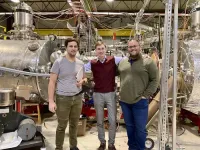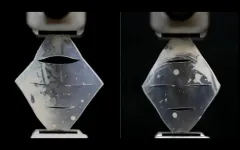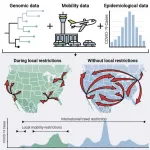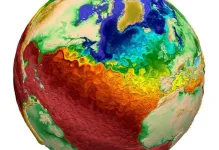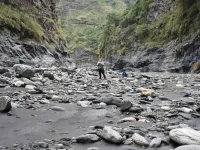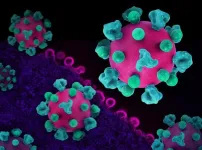(Press-News.org) MADISON – University of Wisconsin–Madison engineers have used a spray coating technology to produce a new workhorse material that can withstand the harsh conditions inside a fusion reactor.
The advance, detailed in a paper published recently in the journal Physica Scripta, could enable more efficient compact fusion reactors that are easier to repair and maintain.
“The fusion community is urgently looking for new manufacturing approaches to economically produce large plasma-facing components in fusion reactors,” says Mykola Ialovega, a postdoctoral researcher in nuclear engineering and engineering physics at UW–Madison and lead author on the paper. “Our technology shows considerable improvements over current approaches. With this research, we are the first to demonstrate the benefits of using cold spray coating technology for fusion applications.”
The researchers used a cold spray process to deposit a coating of tantalum, a metal that can withstand high temperatures, on stainless steel. They tested their cold spray tantalum coating in the extreme conditions relevant to a fusion reactor and found that it performed very well. Importantly, they discovered the material is exceptionally good at trapping hydrogen particles, which is beneficial for compact fusion devices.
“We discovered that the cold spray tantalum coating absorbs much more hydrogen than bulk tantalum because of the unique microstructure of the coating,” says Kumar Sridharan, a professor of nuclear engineering and engineering physics and materials science and engineering. Over the last decade, Sridharan’s research group has introduced cold spray technology to the nuclear energy community by implementing it for multiple applications related to fission reactors.
“The simplicity of the cold spray process makes it very practical for applications,” Sridharan says.
In fusion devices, plasma — an ionized hydrogen gas — is heated to extremely high temperatures, and atomic nuclei in the plasma collide and fuse. That fusion process produces energy. However, some hydrogen ions may get neutralized and escape from the plasma.
“These hydrogen neutral particles cause power losses in the plasma, which makes it very challenging to sustain a hot plasma and have an effective small fusion reactor,” says Ialovega, who works in the research group of Oliver Schmitz, a professor of nuclear engineering and engineering physics.
That’s why the researchers set out to create a new surface for plasma-facing reactor walls that could trap hydrogen particles as they collide with the walls.
Tantalum is inherently good at absorbing hydrogen — and the researchers suspected that creating a tantalum coating using a cold spray process would boost its hydrogen-trapping abilities even more.
Creating a cold sprayed coating is somewhat like using a can of spray paint. It consists of propelling particles of the coating material at supersonic velocities onto a surface. Upon impact, the particles flatten like pancakes and coat the entire surface, while preserving nanoscale boundaries between the coating particles. The researchers discovered that those tiny boundaries facilitate trapping of hydrogen particles.
Ialovega conducted experiments on the coated material at facilities at Aix Marseille University in France and Forschungszentrum Jülich GmbH in Germany. During these experiments, he found that when he heated the material to a higher temperature, it expelled the trapped hydrogen particles without modifying the coatings — a process that essentially regenerates the material so it can be used again.
“Another big benefit of the cold spray method is that it allows us to repair reactor components on site by applying a new coating,” Ialovega says. “Currently, damaged reactor components often need to be removed and replaced with a completely new part, which is costly and time consuming.”
The researchers plan to use their new material in the Wisconsin HTS Axisymmetric Mirror (WHAM). The experimental device is under construction near Madison, Wis., and will serve as a prototype for a future next-generation fusion power plant that UW–Madison spinoff Realta Fusion aims to develop. Housed in the Physical Sciences Laboratory, the WHAM experiment is a partnership between UW–Madison, Massachusetts Institute of Technology and Commonwealth Fusion Systems.
“Creating a refractory metal composite with these features of well-controlled hydrogen handling combined with erosion resistance and general material resilience is a breakthrough for the design of plasma devices and fusion energy systems,” Schmitz says. “The prospect of changing the alloy and including other refractory metals to enhance the composite for nuclear applications is particularly exciting.”
The researchers are patenting their technology through the Wisconsin Alumni Research Foundation.
Oliver Schmitz is the Thomas and Suzanne Werner Professor, associate dean for research innovation in the UW–Madison College of Engineering, and director of the Grainger Institute of Engineering. Sridharan is a Grainger Professor.
Additional co-authors on the paper from UW–Madison include: Tyler Dabney, Marcos Navarro Gonzalez, Hwasung Yeom, Danah Velez, Evan Willing, Jay Anderson, and Cary Forest. Thierry Angot and Régis Bisson from Aix Marseille University in France, and Arkadi Kreter from Forschungszentrum Jülich GmbH in Germany are also co-authors on the paper.
Seed funding for this research came in part from UW–Madison’s Research Forward program. This research was also supported by grants from the Advanced Research Projects Agency-Energy (ARPA-E) and the U.S. Department of Energy.
# # #
--Adam Malecek, acmalecek@wisc.edu
END
Tufts University, home to the world’s largest concentration of academic researchers working on cultivated meat, will be hosting its second annual Cellular Agriculture Innovation Day on January 11, 2024. The day-long event will be held at Tufts’ Joyce Cummings Center in Medford, following a year of major developments in the industry — including regulatory approval of cultivated meat in the United States. Bringing together researchers, entrepreneurs, policymakers, and investors, Cellular Agriculture Innovation Day is an opportunity for candid ...
Washington, D.C. – The Office of Fusion Energy Sciences (FES), at the U.S. Department of Energy’s Office of Science, announced the release of its vision, Building Bridges: A Vision for the Office of Fusion Energy Sciences, during the Fusion Energy Sciences Advisory Committee hearing on December 13, 2023. This FES vision enables DOE to establish the steps needed to help advance fusion energy, including addressing key science and technology gaps in the supply chain and industry, bringing the United States one step closer to achieving net-zero emissions by 2050.
Fusion, the process that powers ...
Researchers from the Harvard John A. Paulson School of Engineering and Applied Sciences (SEAS) have increased the fatigue threshold of particle-reinforced rubber, developing a new, multiscale approach that allows the material to bear high loads and resist crack growth over repeated use. This approach could not only increase the longevity of rubber products such as tires but also reduce the amount of pollution from rubber particles shed during use.
The research is published in Nature.
Naturally occurring rubber latex is soft and stretchy. For a range of applications, including tires, hoses, and dampeners, rubbers are reinforced by ...
LA JOLLA, CA—Elucidating human contact networks could help predict and prevent the transmission of SARS-CoV-2 and future pandemic threats. A new study from Scripps Research scientists and collaborators points to which public health protocols worked to mitigate the spread of COVID-19—and which ones didn’t.
In the study, published online in Cell on December 14, 2023, the Scripps Research-led team of scientists investigated the efficacy of different mandates—including stay-at-home measures, social distancing and travel restrictions—at preventing local and regional transmission during different phases of the COVID-19 pandemic. They found ...
On the beach, ocean waves provide soothing white noise. But in scientific laboratories, they play a key role in weather forecasting and climate research. Along with the atmosphere, the ocean is typically one of the largest and most computationally demanding components of Earth system models like the Department of Energy’s Energy Exascale Earth System Model, or E3SM.
Most modern ocean models focus on two categories of waves: a barotropic system, which has a fast wave propagation speed, and a baroclinic system, which ...
Gastrulation is one of the most important phases in early embryonic development. Before gastrulation, vertebrate embryos are simple two-dimensional sheets of cells. By the end of gastrulation, an embryo will have begun to differentiate distinct cell types, set up the basic axes of the body and internalize some of the precursors for organs in a three-dimensional structure. Amniotes, like chickens and humans, will have developed a primitive streak, the precursor to the brain and skin, while fish and amphibians will have developed a spherical-shaped ...
Herpes simplex virus (HSV) is extremely common, affecting nearly two-thirds of the world’s population, according to the World Health Organization.
Once inside the body, HSV establishes a latent infection that periodically awakens, causing painful blisters on the skin, typically around the nose and mouth. While a mere nuisance for most people, HSV can also lead to dangerous eye infections and brain inflammation in some people and cause life-threatening infections in newborns.
Researchers have long known ...
UNIVERSITY PARK, Pa. — Drones flying along miles of rivers in the steep, mountainous terrain of central Taiwan and mapping the rock properties have revealed new clues about how water helps shape mountains over geological time, according to a team led by Penn State scientists.
The researchers found a link between the size of boulders in the rivers and the steepness of the rivers. The link shows how rock properties can influence the relationship between tectonic processes happening deep underground and how mountainous landscapes ...
WHAT:
An effective HIV vaccine may need to prompt strong responses from immune cells called CD8+ T cells to protect people from acquiring HIV, according to a new study from researchers at the National Institute of Allergy and Infectious Diseases (NIAID), part of the National Institutes of Health, and colleagues. The study findings, appearing in Science, draw comparisons between the immune system activity of past HIV vaccine study participants and people with HIV who naturally keep the virus from replicating even in the absence of antiretroviral ...
Half of all marriages in the United States are likely to fail by the time the spouses reach their 50s. Understandably, many couples are looking for ways to avoid becoming part of that statistic, well aware of a divorce’s possible wide-reaching detrimental effects on families, children, personal finances, individual well-being—and direct and indirect costs to society.
Ronald Rogge, an associate professor of psychology at the University of Rochester, has been researching the complex dynamics ...
